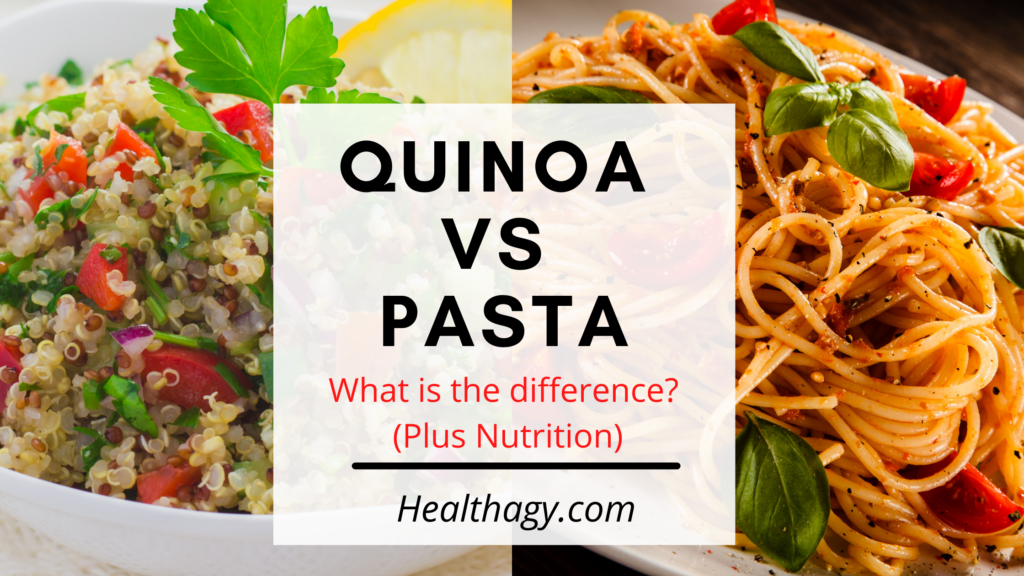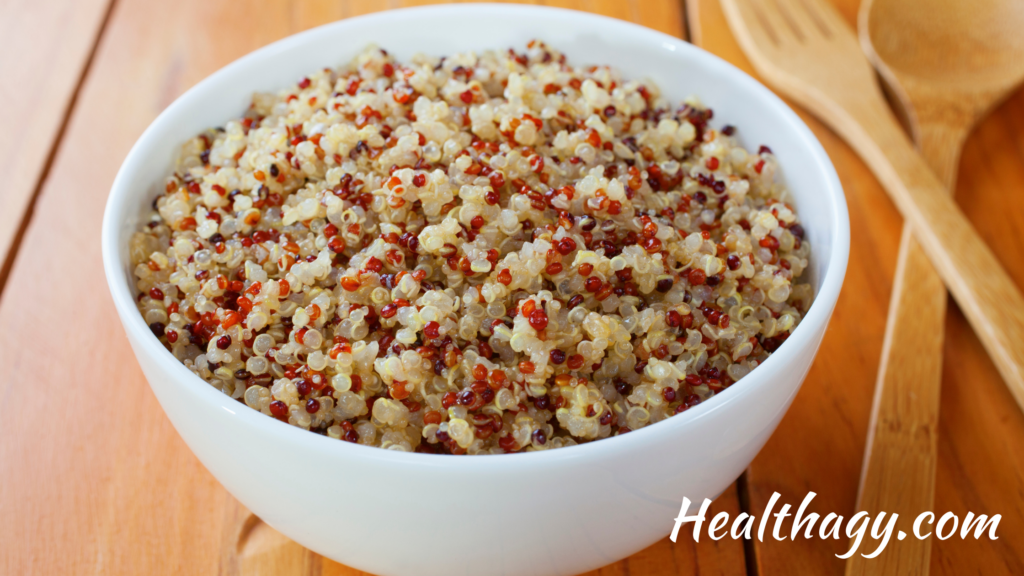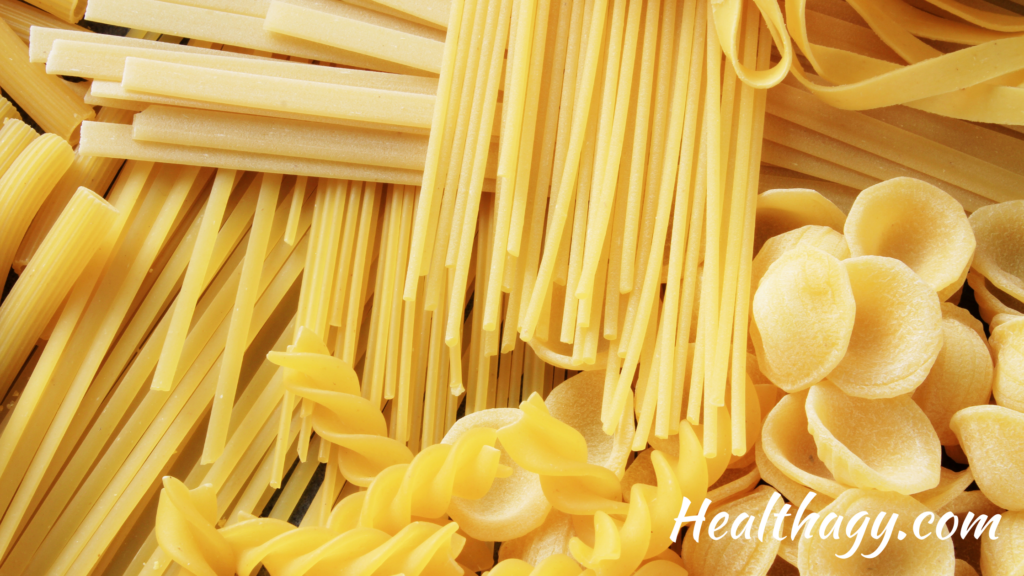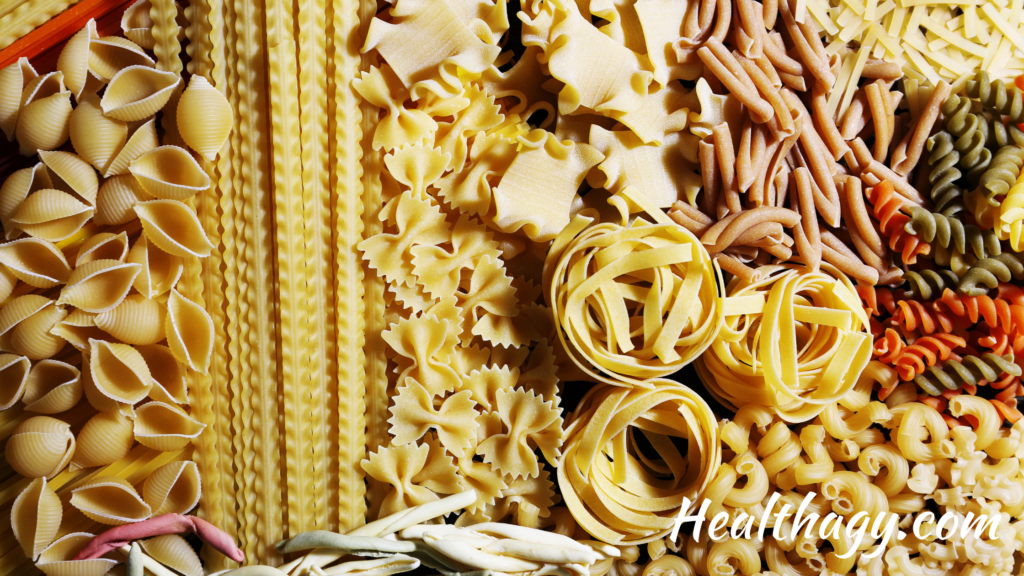
Whether you are looking for a healthy alternative to traditional pasta, learning to navigate the gluten-free diet world, or are just having fun trying out all the new types of pasta nowadays- I’ve got you covered.
In our health-conscious world, we now have so many delicious noodles and healthy grains to choose from! But with so many different types of grains and pasta, the choices can also leave you wondering which one is healthiest for you and offers you the most nutritional value. In this post, we’ll focus on the comparison between quinoa vs pasta.
Key Differences in Quinoa vs Pasta
The main difference between quinoa and pasta is that quinoa is naturally gluten-free. Regular pasta contains gluten. Quinoa can be turned into quinoa pasta and cooked much like regular pasta, making it a great alternative to gluten-free pasta.
Quinoa has fewer calories than pasta, while pasta has more grams of protein. Quinoa is also a great source of naturally occurring vitamins, minerals, and antioxidants.
Pasta is traditionally made with refined flour, which has been stripped of nutrients. Some brands of pasta are enriched with vitamins and minerals.
| Quinoa | Pasta | |
| Gluten-Free | Yes | No |
| Ingredient | Seed | Durum Wheat Flour |
| Whole Grain | Yes | No |
| Calories per 100 g | 120 | 357 |
| Protein per 100 g | 4.4 g | 10.7 g |
| Complete Source of Protein | Yes | No |

What is Quinoa?
Quinoa is an ancient grain that is often eaten as a substitute for rice or couscous. Quinoa is often referred to as “superfood” or “super grain,” as it is packed full of protein, fiber, and various vitamins and minerals. Although quinoa is a seed, nutritionally, it is more like a grain, often called a pseudo-grain. One thing that makes quinoa stand out is that it is one of the few plant sources that qualify as a complete protein source, meaning it contains all 9 essential amino acids.
Quinoa seeds have a slightly bland yet nutty flavor. They come in a few varieties, such as red quinoa, black quinoa, and the most commonly found, white quinoa. Quinoa has become a popular gluten-free alternative.
Much like other gluten-free and whole-grain flours, quinoa can be turned into a very fine flour and turned into pasta, bread, and other baked goods. Making it a great alternative to wheat flour as you get all the nutrients you normally do with the whole seed quinoa, without the gluten from wheat.
Regular quinoa can be a great alternative to pasta and goes well with veggies, chicken, salmon, and other proteins. Just make sure to go light on the sauce if you use a sauce, as quinoa in its natural seed form can’t hold sauce as noodles can.
If you have Celiac disease or are on a strict gluten-free diet, don’t forget to look for the certified gluten-free stamp.

What is Pasta?
Pasta is a dish originally from Italy traditionally made using durum wheat and water. Pasta can come in various shapes and sizes and is traditionally prepared by boiling it over the stove.
Nowadays, pasta is no longer just about size and shape; long gone are the days when you only had to choose between fettuccini, rotini, and macaroni. Today you also get to choose what your pasta is made from; traditional pasta, whole-grain pasta, whole-wheat pasta, gluten-free pasta, bean pasta, quinoa pasta, brown rice pasta, and veggie pasta.

Types of Pasta
There are so many types of pasta available. Below is a quick overview of some popular types of pasta you may find at the store.
Traditional Pasta: Traditional pasta is the regular, white pasta made from durum wheat flour, also known as semolina, a coarse flour made from durum wheat. Without specifying what the pasta is made of, the word “pasta” typically refers to durum wheat pasta. Some pasta is enriched with vitamins and minerals. Traditional pasta is the pasta that is compared to quinoa throughout this post.
Whole-Wheat Pasta: Whole-wheat pasta is similar to regular pasta, except that it is made from whole wheat rather than refined wheat. Regular pasta is made with refined wheat, which is how it is so white in color. Generally, whole grains are typically healthier than refined grains, and they are often brown in color because they are unrefined.
Whole Grain Pasta: 100% whole-grain pasta is made from whole grains, with no refined grains. Typically 100% whole-grain pasta is made with pastas are made with 100% whole grain durum wheat flour. However, it may also include quinoa pasta or brown rice pasta. In general whole grains are typically healthier than refined grains. A package of 100% whole-grain pasta will be marked with a “whole-grain” stamp.
Quinoa Pasta: Quinoa pasta is made from quinoa. It is naturally gluten-free and considered a whole grain. Quinoa pasta is often made with additional flours such as white rice, brown rice, amaranth, or lentil flour.
Rice Pastas: Brown rice pasta and white rice pasta are made from their respective type of rice. Rice is naturally gluten-free. Brown rice pasta is considered a whole grain pasta. White rice pasta would not be whole grain pasta as white rice is refined.
Chickpea, Lentil, and Bean Pastas: These pastas made from lentils or beans tend to be higher in protein, fiber content, and gluten-free.
Veggie Pastas: Veggie pasta can include be a variety of noodles. Some veggie pastas are spiralized veggies such as zucchini. They may also use a flour such as durum wheat and be combined with a vegetable such as zucchini, sweet potato, or spinach in making the noodle. Others are just spiralized vegetables, which is a way of cutting a vegetable to give it a noodle-like shape to give the appearance of being a “pasta.”
Quinoa vs Pasta Nutrition
We’ll look at the key nutritional values of 100 grams each of cooked quinoa compared to an average durum wheat pasta in comparing quinoa vs pasta.
| Quinoa (100g), %Daily Value | Pasta (100g), %Daily Value | |
| Calories | 120 | 357 |
| Total Carbohydrate -Dietary fiber -Sugar | 21 g 2.8 g .87 g | 76 g 3.5 g 3.5 g |
| Protein | 4.4 g | 10.7 g |
| Total Fat Saturated Fat | 1.9 g, 3% 0.23 g, 2 % | 1.5 g, 2 % 0 g |
| Vitamin D | 0 mcg | 0 mcg |
| Calcium | 17 mg, 1% | 0 mg |
| Iron | 1.49 mg, 8% | 1 mg, 4% |
| Potassium | 172 mg, 4% | 214 mg, 4% |
Both quinoa and pasta are low on the glycemic index scale around 50. Foods lower on the glycemic index scale help to regulate blood sugar levels. A tip I’ve learned is that if you cook Pasta Al Dente, which is the Italian word for “to the tooth,” meaning firm to the bite, it not only tastes better, but overcooked pasta may have a higher GI rating.
Quinoa is a good source of several naturally occurring minerals such as manganese, phosphorus, copper, folate, iron, magnesium, and zinc, along with other plant compounds and antioxidants.
Regular pasta made from durum wheat is a refined grain, which means the bran and the germ are removed during the refining process. This also strips away means all of the healthy fiber, vitamins, and minerals from those grains. Some pasta brands will fortify the pasta by adding nutrients back in, such as some B vitamins and minerals, but add back just a small portion of what whole grains naturally contain. But, when it comes to nutrition, naturally occurring fuel is better quality than fortified fuel.
Is Quinoa or Pasta Healthier?
In regards to quinoa vs regular pasta, quinoa is a healthier option overall as it is classified as whole grain and unrefined. Quinoa has more naturally occurring nutrition, while regular pasta is refined, which means you may end up eating more empty calories over quality calories.
Whole grains are naturally high in fiber, helping you feel full and satisfied, which can help in weight management. Whole grains have been linked to helping lower the risk of heart disease, diabetes, certain cancers, and other health-related problems.
Tip: Quinoa pasta is often blended with additional ingredients such as rice or amaranth, which can still make it a great gluten-free alternative to wheat pasta, but it may not be as nutrient-dense as whole seed quinoa. Make sure to check ingredient labels and not just the front of the package to know what you are eating or stick with regular quinoa (not in pasta form).
Whether quinoa is your jam or you love traditional pasta. The good news is that the stores are filled with whole-grain pastas, healthy grains, and alternative pasta options that there are surely options that can satisfy your taste buds and health.
Read More:
How Long Does Cooked Quinoa Last?
Karla Kueber is a Certified Evidence Based EFT Practioner and Health Coach, with a double Masters Degree in Education. She works with people to overcome emotional eating, curb cravings, and overcome resistance to eating new healthy foods. You can learn more about coaching with her here.